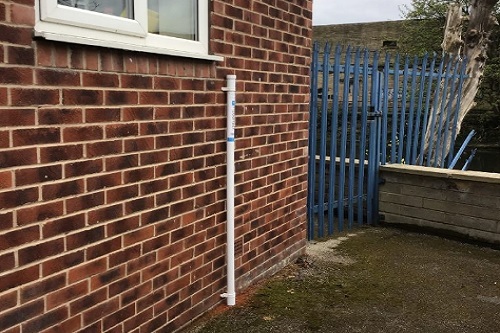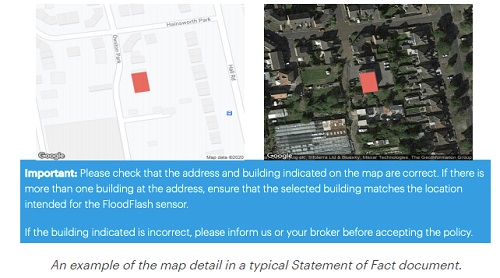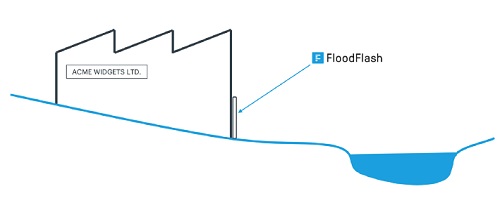Where should I put my FloodFlash sensor?

FloodFlash policies operate a little differently to traditional insurance policies. This is the first in a series of posts that give simple answers to those most common questions. In the series, we’ll be covering choosing a place to install your sensor, selecting a settlement amount, selecting a trigger depth, and more.
Some key facts about the sensor
Each FloodFlash sensor is 155cm long and 5.4cm wide. They measure flood depths and tell us to start a claim when flooding reaches your trigger depth. When installed it looks like a piece of nondescript plumbing. Here’s an example of an installed sensor:
The sensors are key to FloodFlash claims. The data they provide helps FloodFlash validate and pay claims in full a single day after a flood (just like we did during Storm Ciara). Each sensor is:
- Smart: each sensor has ultrasonic depth measurement technology (like a parking sensor) and internet connectivity to send us the data is collects.
- Durable: the sensor is storm and tamper proof. The battery lasts 10+ years and if networks fail in a storm we can collect the data from a built in memory chip.
- Simple: the sensor uses proven tech that has been around for a long time. Plus we can organise no-fuss replacements if needed.
After installation the sensor works by itself and we monitor sensor data regularly. You only need to contact us about it if you spot that it is damaged so we can organise repair/replacement.
Where can I PLACE the sensor?
The sensor is important to your policy. It is what makes FloodFlash claims simple and fast so it comes with a few standard rules. If you don’t follow these rules there is a risk we may refuse a claim, cancel your policy or charge an admin fee to move the sensor or update your policy.
Just remember PLACE when it comes to the sensor and you won’t go far wrong. PLACE stands for: Property, Level, Abuts, Cost, Engineer. Let’s take a look at those in more detail:
Property: The sensor must be installed on the property identified in your Statement of Fact. It is important that you review the Statement of Fact document that comes with each quote. It includes a map and satellite view of the property selected for the quote – example above. If you want to place the sensor on a property/wall other than that indicated in the picture you need to apply for a new quote.

Level: The sensor must be at (or above) ground level. You cannot choose a site down a drain, stairway or depression that leaves the bottom end of the sensor below ground level.
Abuts: you must not place the sensor on a wall that touches or abuts water. E.g. a building next to a river. That includes where a wall goes down to meet the water below ground level.
Cost: The sensor costs £100+VAT per year. This covers licensing and servicing. Initial installation is provided at no extra cost.
Engineer: The installation engineer cannot advise you. You must choose where the installation site to best suit your needs.
Contact your broker or reach out to us directly if you have any questions at all. We’re happy to help.
Ok, I now know where it can go… but where should it go?
We leave this decision to you because you know your property better than we do. Most customers put the sensor in the area that they believe will flood first, typically the part at lowest elevation or closest to a water source.
We don’t dictate which wall of the building the sensor goes on provided you follow the PLACE rules. If the rear of your property is lower and is more likely to flood deeper than the front, and it would make sense to put your sensor there, then that’s no problem at all. Equally, if you wanted to put it somewhere else, that’s also no problem.

Lots of customers decide to put the sensor on the part of the building they think is most likely to flood first — like the low point close to the river shown here — which is totally fine. If you wanted to put it somewhere else, that’s also fine. Just remember PLACE at all times.
Where have other customers put their sensor?
As above, most customers select the area they think is most likely to flood first, and likely to experience the deepest flood. For customers whose property has no area more likely to flood than another (e.g. on flat, level ground) we have seen them select a location based on aesthetics or convenience — out of the way around the side or on the back of the building, for example, rather than on a shop-front. This is also totally fine.
Another factor to bear in mind is that it can be useful to place the sensor next to something that allows you to tangibly select a trigger height — for example, if someone has installed flood barriers to protect their property up to 60cm, they might put their FloodFlash sensor next to the barrier and select a trigger height of 60cm. They then know that they will receive their settlement at the same depth that the barriers become overwhelmed.
An important thing to remember when placing your sensor is that the pay-out is dictated by the flood depth above ground level, as measured by the sensor, at the point at which the sensor is installed. There’ll be more on this in our upcoming post on choosing a trigger depth.
What height is the sensor installed at?
Most sensors sit with the base at ground level. This will almost always be the case for and any trigger-depth up to 1.2m. If you opt for a higher trigger depth, the sensor will be mounted higher on the wall. This will all be taken care of by our trusted installation engineer — you don’t need to do anything different.
What’s the installation process?
Our trusted engineers install every sensor – no DIY required. When you purchase your FloodFlash policy, your broker will ask for your preferred dates and times for the installation of your sensor. Once booked, Tom (who runs operations here at FloodFlash) will arrange for your sensor to be shipped. Your installation engineer will call you a day or so in advance to confirm arrangements.
Before the engineer arrives you’ll need to have chosen a location for your sensor and will need to make sure the area is free from obstructions for them access to the site.
About FloodFlash
FloodFlash is a new type of rapid-payout flood insurance. It uses the latest data modelling and connected tech to bring parametric insurance to the mass market for the first time. The result is fast, easy and flexible cover that pays claims within days of a flood.
FloodFlash is parametric or `event-based` insurance. When buying the cover, the client chooses the depth of flooding they wish to insure against and how much they’d receive when that flood happens. When the FloodFlash sensor installed at the property detects flood water at the selected depth, the claim is paid in full. No waiting. No haggling.
FloodFlash rapid-payouts were put to the test in February 2020 when Storm Ciara swept across the UK. Claims related to the storm were paid in full within a single day. That speed of claims payment remains the fastest and best proof of mass-market parametric insurance to date gaining acclaim at industry awards and recognition from The Times, The Telegraph and the BBC.
FloodFlash operates across Britain, is headquartered in London. Floodflash is a registered coverholder at Lloyd`s of London and is authorised and regulated by the Financial Conduct Authority.

